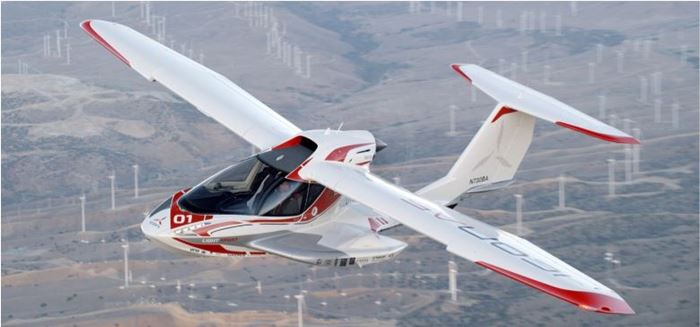ICON Aircraft constructs and flies first production A5
Amphibious light sport aircraft features carbon fiber composite construction; first model to be made using production tooling and components unveiled at OshKosh.
ICON Aircraft (Los Angeles, Calif., USA) unveiled the first production A5 — an amphibious light sport aircraft made from carbon fiber composites — at the 2014 EAA AirVenture in Oshkosh, Wisconsin. Referred to as Engineering Serial Number 1 (ESN·1), this is the first A5 built from the production design, with production tooling, and using production methods and components. ESN-1 was built over a five-month period, from January to June of 2014, and successfully completed its first flight on 7 July 2014 in Tehachapi, California. This aircraft is one of three that will be used to verify performance and complete FAA approval prior to the start of customer deliveries in May 2015.
"This is one of the most significant milestones to date for ICON. It represents the culmination of years of research, design, engineering, and manufacturing dedication by an outstanding team," said ICON Aircraft Founder and CEO Kirk Hawkins. "The A5 is no longer a prototype or concept aircraft. It's a sophisticated, production-ready, consumer-focused aircraft. The entire ICON team is pouring its heart and soul into bringing the A5 to our customers, and it shows in the truly exceptional execution of the product. I couldn't be prouder."
"The A5's development has been a massive undertaking," said ICON VP of Engineering and CEO Matthew Gionta. "The amount of intellectual horsepower and years of relentless commitment that has gone into this aircraft is impressive. The ICON team worked tirelessly to make the A5 a reality; it is difficult to convey the magnitude of work involved to bring a new aircraft to market, much less one balancing all the demanding design requirements of the A5. Before we could even begin designing the aircraft's 1600-plus unique components, the team spent thousands of hours designing, building, testing, and iterating the proof of concept aircraft to get it right. Only then could we design the production parts, the tools to manufacture them, and work with the 100 or so suppliers that are contributing components to the A5," explained Gionta. "With ESN-1 complete and ESN-2 under construction, we are now looking toward FAA approval, after which we will begin customer deliveries. I can't wait for our customers to finally experience the finished product."
ESN-1 was built at ICON's facility in Tehachapi, California, and made its first flight from the Tehachapi Municipal Airport earlier this month. "ESN-1 performed very well on its first flight," said ICON Test Pilot and Lead Aero Engineer Jon Karkow, who was at the controls for the flight. "Its flight characteristics are similar to the proof of concept aircraft, which logged over 700 flights, with the same responsive character and control harmony. The hard work of the engineering and production teams is very clear."
A second production prototype, ESN-2, is currently under construction and is scheduled for completion and structural testing this fall. The first three aircraft built will support the FAA approval process, and the third aircraft will be delivered to the first customer after that process is complete.
ICON recently announced that it would begin operating in its new 140,000 ft2 facility in
Vacaville, California in early 2015. The company is currently readying the factory and offices to begin full-scale manufacturing. Once at full production rates, the factory will be capable of producing more than 500 aircraft per year.
Related Content
Plant tour: Spirit AeroSystems, Belfast, Northern Ireland, U.K.
Purpose-built facility employs resin transfer infusion (RTI) and assembly technology to manufacture today’s composite A220 wings, and prepares for future new programs and production ramp-ups.
Read MoreInfinite Composites: Type V tanks for space, hydrogen, automotive and more
After a decade of proving its linerless, weight-saving composite tanks with NASA and more than 30 aerospace companies, this CryoSphere pioneer is scaling for growth in commercial space and sustainable transportation on Earth.
Read MoreMaterials & Processes: Resin matrices for composites
The matrix binds the fiber reinforcement, gives the composite component its shape and determines its surface quality. A composite matrix may be a polymer, ceramic, metal or carbon. Here’s a guide to selection.
Read MoreNovel dry tape for liquid molded composites
MTorres seeks to enable next-gen aircraft and open new markets for composites with low-cost, high-permeability tapes and versatile, high-speed production lines.
Read MoreRead Next
From the CW Archives: The tale of the thermoplastic cryotank
In 2006, guest columnist Bob Hartunian related the story of his efforts two decades prior, while at McDonnell Douglas, to develop a thermoplastic composite crytank for hydrogen storage. He learned a lot of lessons.
Read MoreCW’s 2024 Top Shops survey offers new approach to benchmarking
Respondents that complete the survey by April 30, 2024, have the chance to be recognized as an honoree.
Read MoreComposites end markets: Energy (2024)
Composites are used widely in oil/gas, wind and other renewable energy applications. Despite market challenges, growth potential and innovation for composites continue.
Read More




























